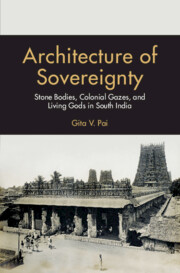Book contents
- Frontmatter
- Dedication
- Contents
- List of Figures
- Acknowledgments
- Notes on Transliteration and Spelling
- Introduction: Sovereignty’s Trace in Architectural Forms
- Part I Stone Bodies
- Part II Colonial Gazes
- Part III Living Gods
- Epilogue: Rejecting the State—Priestly Devotion and Protest in Modern Madurai
- Bibliography
- Index
6 - Photographing Madura: The Living Temple as a Site of Ruin
Published online by Cambridge University Press: 19 April 2023
- Frontmatter
- Dedication
- Contents
- List of Figures
- Acknowledgments
- Notes on Transliteration and Spelling
- Introduction: Sovereignty’s Trace in Architectural Forms
- Part I Stone Bodies
- Part II Colonial Gazes
- Part III Living Gods
- Epilogue: Rejecting the State—Priestly Devotion and Protest in Modern Madurai
- Bibliography
- Index
Summary
Introduction
In 1933, Edith Storrs offered a large donation of photographs from her family collection to the Victoria and Albert Museum, London: “I do not want them,” she wrote in her letter, “as this house is not v[ery] big, but if you think that any of them are of interest now, & would care to look through them, I will gladly send them….” Captain Linnaeus Tripe, Storrs’ grand-uncle, was a photographer working for the East India Company's Madras Presidency in the mid-nineteenth century, and he produced many prints of the Tamil country in south India. With the arrival of photography in India during the 1840s, the expeditions of British soldiers and civil servants were recorded in extravagant albums with extensive annotations, which gave credibility to the imperial project and catered to the British public's craving for oriental travel narratives.
Some scholars have argued for an analytical separation between these photographs and the texts which accompany them. John Falconer, British Library's former curator of visual arts from the Indian subcontinent, believed that only the photographs’ written explanations convey a clear political agenda, whereas the images in themselves were “politically neutral interpretations of architecture and topography.” For instance, J. A. C. Boswell of the Madras Civil Service expressed in his commentary of Tripe's 1858 Views of Ryakotta and Other Places in the Salem District: “Every thing speaks in language that cannot be mistaken, that a brighter day has already dawned in India.” In Boswell's writing, the ruins of a dilapidated fort were a solemn and picturesque reminder of “the anarchy which generally prevailed” in earlier periods of history, contrary to “Christian European Civilization” that would make the “influences of her Government manifest in their social, moral, and political advancement.” The extraordinary images represented the ‘reward’ of civilizational conquest: “There is a magnificent view from the top of Ryakotta hill that will well repay the difficulty of ascent.”
Falconer's assessment of ‘neutrality’ in Tripe's photographs is premised on the problematic notion that the camera captures images detached from the subjectivity of the photographer. As John Berger reminds us,
a photograph bears witness to a human choice being exercised…. A photograph, whilst recording what has been seen, always and by its nature refers to what is not seen. It isolates, preserves and presents a moment taken from a continuum….
- Type
- Chapter
- Information
- Architecture of SovereigntyStone Bodies, Colonial Gazes, and Living Gods in South India, pp. 201 - 238Publisher: Cambridge University PressPrint publication year: 2023

